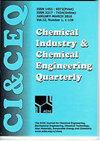The influence of moisture content on drilled cuttings’ properties of bed packing and flowability
IF 0.8
4区 工程技术
Q4 CHEMISTRY, APPLIED
Chemical Industry & Chemical Engineering Quarterly
Pub Date : 2023-01-01
DOI:10.2298/ciceq230424023a
引用次数: 0
Abstract
To design and operate various equipment of the solids control system in offshore drilling platforms, it is important to establish how the moisture content influences the characteristics of drilled cuttings to form packed beds and flow over solid surfaces. The current study provides a comprehensive analysis of how moisture content, primarily composed of water and representing Water-based muds (WBMs), influences the properties of bed packing and flowability of drilled cuttings. The particle aggregation/disaggregation dynamics, loose and tapped bulk densities and porosities, compaction dynamics of packed beds, Hausner ratio, and angle of repose of drilled cuttings with ten distinct moisture contents (1.4-44.0 wt%) were analyzed. It was noticed that the increment of moisture content up to 15.2% promoted the formation of looser interparticle structures. However, these structures were steadier, showing greater difficulty to flow and release air/liquid. The continuous increment of moisture content beyond 15.2%, promoted a complete change in the material behavior. The interparticle structures became denser. The material could flow and release air/liquid more easily. In addition, it was possible to establish a classification of the different behaviors of drilled cuttings according to the moisture content. Predictive models were proposed to describe the influence of the moisture content on the bed packing and flowability properties of drilled cuttings.含水率对钻屑床层充填性能和流动性的影响
为了设计和操作海上钻井平台固控系统的各种设备,确定含水率如何影响钻井岩屑形成充填层并在固体表面上流动的特性是很重要的。目前的研究全面分析了含水率(主要由水组成,代表水基泥浆(wbm))如何影响床层填料的性质和钻屑的流动性。分析了10种不同含水率(1.4-44.0 wt%)的钻屑的颗粒聚集/分解动力学、松散和松散的体积密度和孔隙率、充填层的压实动力学、豪斯纳比和休止角。当含水率增加到15.2%时,颗粒间结构的形成更加松散。然而,这些结构更稳定,表现出更大的流动和释放空气/液体的困难。含水率持续增加超过15.2%,促进了材料性能的完全改变。粒子间结构变得更加密集。这种材料可以更容易地流动和释放空气/液体。此外,还可以根据含水率对钻出岩屑的不同行为进行分类。提出了描述含水率对岩屑床层充填和流动特性影响的预测模型。
本文章由计算机程序翻译,如有差异,请以英文原文为准。
求助全文
约1分钟内获得全文
求助全文
来源期刊

Chemical Industry & Chemical Engineering Quarterly
CHEMISTRY, APPLIED-ENGINEERING, CHEMICAL
CiteScore
2.10
自引率
0.00%
发文量
24
审稿时长
3.3 months
期刊介绍:
The Journal invites contributions to the following two main areas:
• Applied Chemistry dealing with the application of basic chemical sciences to industry
• Chemical Engineering dealing with the chemical and biochemical conversion of raw materials into different products as well as the design and operation of plants and equipment.
The Journal welcomes contributions focused on:
Chemical and Biochemical Engineering [...]
Process Systems Engineering[...]
Environmental Chemical and Process Engineering[...]
Materials Synthesis and Processing[...]
Food and Bioproducts Processing[...]
Process Technology[...]
 求助内容:
求助内容: 应助结果提醒方式:
应助结果提醒方式:


